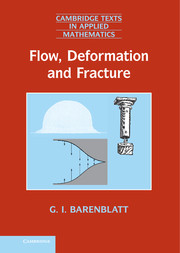 Flow, Deformation and Fracture
Flow, Deformation and Fracture Book contents
- Frontmatter
- Dedication
- Contents
- Foreword
- Preface
- Introduction
- 1 Idealized continuous media: the basic concepts
- 2 Dimensional analysis and physical similitude
- 3 The ideal incompressible fluid approximation: general concepts and relations
- 4 The ideal incompressible fluid approximation: analysis and applications
- 5 The linear elastic solid approximation. Basic equations and boundary value problems in the linear theory of elasticity
- 6 The linear elastic solid approximation. Applications: brittle and quasi-brittle fracture; strength of structures
- 7 The Newtonian viscous fluid approximation. General comments and basic relations
- 8 The Newtonian viscous fluid approximation. Applications: the boundary layer
- 9 Advanced similarity methods: complete and incomplete similarity
- 10 The ideal gas approximation. Sound waves; shock waves
- 11 Turbulence: generalities; scaling laws for shear flows
- 12 Turbulence: mathematical models of turbulent shear flows and of the local structure of turbulent flows at very large Reynolds numbers
- References
- Index
Preface
Published online by Cambridge University Press: 05 June 2014
- Frontmatter
- Dedication
- Contents
- Foreword
- Preface
- Introduction
- 1 Idealized continuous media: the basic concepts
- 2 Dimensional analysis and physical similitude
- 3 The ideal incompressible fluid approximation: general concepts and relations
- 4 The ideal incompressible fluid approximation: analysis and applications
- 5 The linear elastic solid approximation. Basic equations and boundary value problems in the linear theory of elasticity
- 6 The linear elastic solid approximation. Applications: brittle and quasi-brittle fracture; strength of structures
- 7 The Newtonian viscous fluid approximation. General comments and basic relations
- 8 The Newtonian viscous fluid approximation. Applications: the boundary layer
- 9 Advanced similarity methods: complete and incomplete similarity
- 10 The ideal gas approximation. Sound waves; shock waves
- 11 Turbulence: generalities; scaling laws for shear flows
- 12 Turbulence: mathematical models of turbulent shear flows and of the local structure of turbulent flows at very large Reynolds numbers
- References
- Index
Summary
(1) Mechanics, the science of the motion and equilibrium of real bodies, is the oldest natural science created by humankind. Unlike other scientific disciplines, mechanics had no predecessors. Prehistoric human beings started to take their first steps in mechanics – apparently even before starting to speak – when they invented and improved their first primitive tools.
Later, when humankind took its first steps in mathematics, mechanics was the first field of application. The value of mechanics for mathematics was clearly emphasized by Leonardo da Vinci: “Mechanics is the paradise for mathematical sciences because through it one comes to the fruits of mathematics.”
Nowadays mechanics is an organic part of applied mathematics – the art of designing mathematical models of phenomena in nature, society and engineering.
The development of mechanics, and the recognition of its value, has not gone smoothly over the centuries. An analogy of mechanics with the phoenix comes to mind. This legendary bird has appeared with practically identical magical features in the ancient legends of many cultures: Egyptian, Chinese, Hebrew, Greek, Roman, native North American, Russian and others. The names were different: the name “phoenix” was coined by the Assyrians; Russians called it “zhar-ptitsa” (fire-bird). According to the legend, unlike all other living beings the phoenix had no parents, and death could never touch it. However, from time to time, when it was weakened, the phoenix would carefully prepare a fire from aromatic herbs collected from throughout the world and burn itself. Everything superfluous is burnt in the fire and a new beautiful creative life opens to the phoenix.
- Type
- Chapter
- Information
- Flow, Deformation and FractureLectures on Fluid Mechanics and the Mechanics of Deformable Solids for Mathematicians and Physicists, pp. xiii - xxPublisher: Cambridge University PressPrint publication year: 2014


